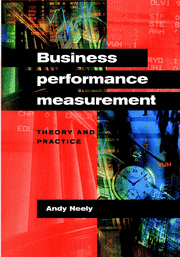Book contents
- Frontmatter
- Contents
- List of contributors
- Preface
- Part I Performance measurement – functional analyses
- Part II Performance measurement – theoretical foundations
- Part III Performance measurement – frameworks and methodologies
- 9 Performance measurement frameworks: A review
- 10 The critical few: First among equals as parameters of strategic effectiveness
- 11 Integrated performance measurement systems: Structure and dynamics
- 12 Why measurement initiatives succeed and fail: The impact of parent company initiatives
- Part IV Performance measurement – practical applications
- Part V Performance measurement – specific measures
- Part VI Performance measurement – emerging issues and trends
- Index
11 - Integrated performance measurement systems: Structure and dynamics
from Part III - Performance measurement – frameworks and methodologies
Published online by Cambridge University Press: 06 July 2010
- Frontmatter
- Contents
- List of contributors
- Preface
- Part I Performance measurement – functional analyses
- Part II Performance measurement – theoretical foundations
- Part III Performance measurement – frameworks and methodologies
- 9 Performance measurement frameworks: A review
- 10 The critical few: First among equals as parameters of strategic effectiveness
- 11 Integrated performance measurement systems: Structure and dynamics
- 12 Why measurement initiatives succeed and fail: The impact of parent company initiatives
- Part IV Performance measurement – practical applications
- Part V Performance measurement – specific measures
- Part VI Performance measurement – emerging issues and trends
- Index
Summary
Introduction
The objective of this chapter is to provide an insight in to the background research, development, and practical application of the Integrated Performance Measurement Systems (IPMS) Reference Model and the associated audit method. The research described was conducted by a multidisciplinary team based at the Centre for Strategic Manufacturing, University of Strathclyde. The research was funded through EPSRC and industry.
The point of departure for this work was that:
1 There are various performance measurement systems models, frameworks, and methodologies available – such as SMART (Cross and Lynch, 1988–9), Performance Measurement Questionnaire (Dixon, Nanni, and Vollmann, 1990), Performance Measurement for World Class Manufacture (Maskell, 1989), Performance Criteria System (Globerson, 1985), Cambridge Performance Measurement Design Process (Neely, Gregory, and Platts, 1995; Neely et al., 1996) and Balanced Scorecards (Kaplan and Norton, 1992 and 1996).
2 Other fields, such as Quality Management and Environmental Management, have auditable reference models and standards that describe the structure and content of a robust management system, i. e. ISO9000, QS9000, and ISO14000.
3 However, an auditable reference model, which describes the structure and constituent parts of a robust, integrated, efficient, and effective performance measurement system, was not available (Bititci, Carrie, and McDevitt, 1996).
The overall aim of the work was to establish whether an auditable reference model for IPMS could be developed. The more specific objectives included:
to research and model the hierarchical structure and relationships between performance measures.
to research and develop a reference model for comparison and benchmarking of integrated performance measurement systems;
to provide a workbook and computer-based analysis tool to assist companies in auditing their performance measurement systems;
to illustrate the methods developed using industrial case studies.
- Type
- Chapter
- Information
- Business Performance MeasurementTheory and Practice, pp. 174 - 197Publisher: Cambridge University PressPrint publication year: 2002
- 17
- Cited by



